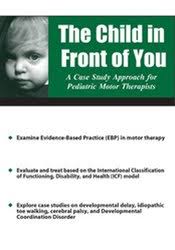The Child in Front of You: A Case Study Approach for Pediatric Motor Therapists – Michelle Fryt Linehan | Available Now !
$199.00 Original price was: $199.00.$56.00Current price is: $56.00.
The Child in Front of You: A Case Study Approach for Pediatric Motor Therapists – Michelle Fryt Linehan | Instant Download !
Pediatric motor therapists see children of all ages with a variety of diagnoses. It can be overwhelming to decide how to evaluate and treat any given patient. In addition, each child is unique, and a “cookie cutter” approach to assessment and treatment should be avoided. One must base the treatment plan on the child’s particular attributes, the family’s wants and needs, and the therapeutic environment.
This recording will introduce therapists to the use of the ICF model and Evidence-Based Practice (EBP) and show how these can be utilized to move from the initial evaluation until discharge, keeping the child, family, and environment as fundamental pieces of this process. This will be done in a case study format that will encourage general discussion. Diagnoses to be discussed include cerebral palsy, developmental delay, idiopathic toe walking, and Developmental Coordination Disorder.
- Define the uses of evidence-based practice and the ICF model, in assessment and evaluation of children with motor issues
- Develop ways to assess and treat children with developmental delay, idiopathic toe walking, Developmental Coordination Disorder, and cerebral palsy using the ICF as a template, and decide on appropriate frequency of therapy, including when to discharge or discontinue therapy
- Restate commonly-used assessment and treatment tools such as standardized assessments, Goal Attainment Scale, Botox, partial body weight-bearing, stretching, strengthening, and electrical stimulation using recent research
- Receive information on useful, though often unknown, assessment and treatment protocols and techniques such as the COMPS, COPM, M-ABC2, and TGMD-2
- Identify an observational tool that can be used to gain useful information on the movement patterns of any child
- Create a plan of care with evidence-based interventions
CURRENT MODELS FOR DECISION-MAKING
International Classification of Functioning, Disability, and Health (ICF)
- Description of short lists
Evidence-Based Practice/Rehabilitation
- Important concepts
- Awareness
- Consultation
- Creativity
- Judgment
CASE STUDY #1: CHILD WITH CEREBRAL PALSY
Description of Child
- Diagnosis/background/video
- Family’s goals
- Goal Attainment Scale (GAS)
Use of Observation as Evaluation Tool
- PIQ form
Use of ICF Template to Discuss Evaluation and Treatment Ideas
- Evaluation tools for infants to older children
- GMFCS
- MACS
- GMFM
- Spasticity vs. hypertonicity
- Oregon Project
- Cortical visual impairment scale
- Caroline Curriculum
- UE assessments
- SCALE
- Intervention ideas
- Kinesiotape
- Aerobic exercise
- Adaptive equipment
- Electrical stimulation
- Partial body weight training
- Theratogs TM
- When to discharge, discontinue, decrease therapy
CASE STUDY #2: CHILD WITH DEVELOPMENTAL DELAY
Description of Child Diagnosis
- Background
- Video
- Family’s goals
Use of Observation as an Evaluation Tool
- PIQ form
Use of ICF Template to Discuss Evaluation and Treatment Ideas
- Evaluation tools for infants to preschoolers
- BSIDIII
- PDMS-2
- TIMP/TIMPS
- DAYC
- HELP
- Lois Bly’s checklist
- Intervention ideas
- When to discharge, decrease, change in frequency
CASE STUDY #3: CHILD WITH IDIOPATHIC TOE WALKING (ITW)
Description of Diagnosis
- Evidence-based practice related to ITW diagnosis and assessment
- Toe walking tool
- Visually-related issues
- Weakness related to biomechanics
- Sensory processing issues
- Long-term sequelae
- Goals:
- Patient’s/family’s
- Clinical outcomes desired
ICF Format for Assessment and Interventions
- Assessments
- Body function
- Structure
- Activities and participation
- Interventions
- Evidence-based practice related to ITW treatment
- Separation by etiology
- Cincinnati Children’s Hospital Algorithm
- Motor control sequence ideas
- Lengthen and strengthen
- Casting
- Orthotics
- Surgery
- Weight on heels
- Sensory approach
CASE STUDY #4: CHILD WITH DEVELOPMENTAL COORDINATION DISORDER (DCD)
Deciding on this Diagnosis
- Definition and diagnostic code
- Research related to co-morbidities
- Profile of child with DCD
- DCD questionnaire for parents
Assessment
- Tests most commonly used
- M-ABC2
- BOT-2
- COPM
- COMPS
Intervention
- Intervention from research
- Dynamic systems vs. deficit-oriented
- Neuromuscular task training
- Cognitive orientation to occupational performance
- Deficit-oriented
- Proprioception
- Strength
- Timing
Other Research Ideas
- Use of aquatic therapy and protocol
- Rhythmic movement training
- Motor imagery
- Infinity walk
Case Study
Tag: The Child in Front of You: A Case Study Approach for Pediatric Motor Therapists – Michelle Fryt Linehan Review. The Child in Front of You: A Case Study Approach for Pediatric Motor Therapists – Michelle Fryt Linehan download. The Child in Front of You: A Case Study Approach for Pediatric Motor Therapists – Michelle Fryt Linehan discount.
1 review for The Child in Front of You: A Case Study Approach for Pediatric Motor Therapists – Michelle Fryt Linehan | Available Now !
Add a review Cancel reply
Related products
Ecommerce
NLP & Hypnosis
Ecommerce
NLP & Hypnosis
NLP & Hypnosis












Kiera Collier –
I recommend dealing with this person because very committed and cooperative. | The Child in Front of You: A Case Study Approach for Pediatric Motor Therapists – Michelle Fryt Linehan